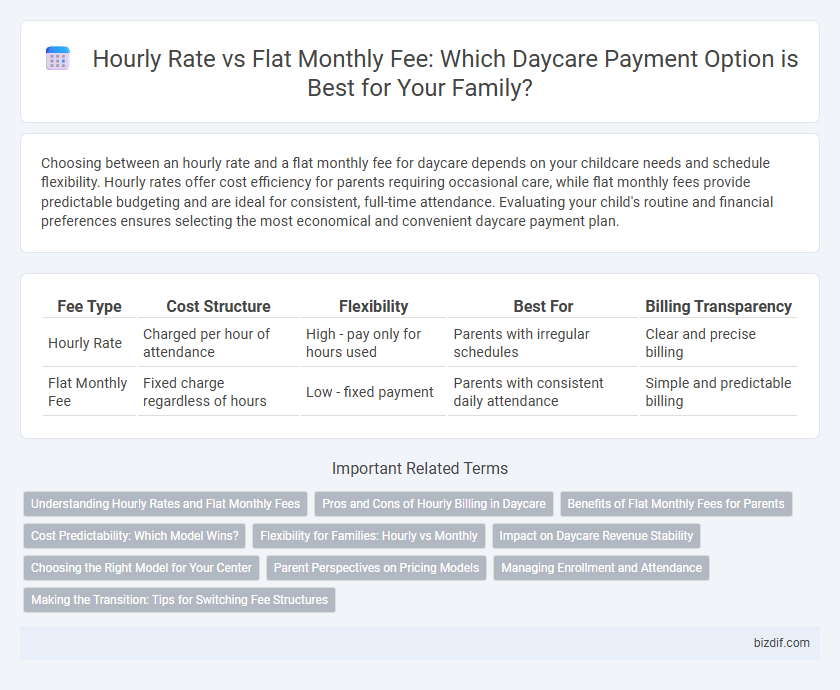Choosing between an hourly rate and a flat monthly fee for daycare depends on your childcare needs and schedule flexibility. Hourly rates offer cost efficiency for parents requiring occasional care, while flat monthly fees provide predictable budgeting and are ideal for consistent, full-time attendance. Evaluating your child's routine and financial preferences ensures selecting the most economical and convenient daycare payment plan.
Table of Comparison
| Fee Type | Cost Structure | Flexibility | Best For | Billing Transparency |
|---|---|---|---|---|
| Hourly Rate | Charged per hour of attendance | High - pay only for hours used | Parents with irregular schedules | Clear and precise billing |
| Flat Monthly Fee | Fixed charge regardless of hours | Low - fixed payment | Parents with consistent daily attendance | Simple and predictable billing |
Understanding Hourly Rates and Flat Monthly Fees
Hourly rates for daycare typically charge parents based on the exact hours their child attends, offering flexibility for irregular schedules but potentially leading to higher costs during busy periods. Flat monthly fees provide a consistent payment regardless of hours used, simplifying budgeting and often granting access to a full-time program with set services. Understanding these pricing structures helps parents choose the best financial arrangement aligned with their childcare needs and usage patterns.
Pros and Cons of Hourly Billing in Daycare
Hourly billing in daycare offers flexibility for parents who require occasional or part-time care, allowing them to pay only for the actual hours used, which can be cost-effective for irregular schedules. This pricing model may lead to unpredictability in monthly expenses and can complicate budgeting for families who need consistent, long-term care. Daycare centers benefit from hourly rates by optimizing revenue during fluctuating demand but may face administrative challenges in tracking precise attendance and billing accurately.
Benefits of Flat Monthly Fees for Parents
Flat monthly fees offer parents predictable childcare expenses, enabling easier budgeting without concerns about fluctuating hourly costs. This pricing model encourages consistent attendance and fosters stronger bonds between children and caregivers due to regular interaction. Parents also benefit from simplified billing processes, reducing administrative hassle and allowing more focus on their child's development.
Cost Predictability: Which Model Wins?
Choosing between hourly rates and flat monthly fees for daycare significantly impacts cost predictability for families. Flat monthly fees provide consistent, predictable expenses regardless of attendance variability, easing monthly budgeting. Hourly rates fluctuate based on hours used, potentially causing unexpected costs and making financial planning more challenging.
Flexibility for Families: Hourly vs Monthly
Hourly rates offer families maximum flexibility by allowing payment strictly for the actual hours their child attends daycare, accommodating irregular schedules and part-time care needs. Flat monthly fees provide predictable costs that simplify budgeting but may not suit families with fluctuating childcare hours. Choosing between hourly and monthly payment options depends on balancing cost efficiency with the family's scheduling flexibility requirements.
Impact on Daycare Revenue Stability
Hourly rates create variable income streams that fluctuate with attendance, leading to unpredictable revenue for daycare centers. Flat monthly fees ensure consistent cash flow by charging families a fixed amount regardless of usage, enhancing financial stability. Balancing these pricing models can optimize revenue predictability and support long-term operational planning.
Choosing the Right Model for Your Center
Choosing the right payment model for your daycare center depends on your target families' needs and your operational goals. Hourly rates offer flexibility for parents needing occasional care and can increase revenue during peak times, while flat monthly fees provide predictable income and simplify billing. Analyze enrollment patterns and market demand to determine whether an hourly or flat fee structure will optimize both customer satisfaction and financial stability.
Parent Perspectives on Pricing Models
Parents often weigh the flexibility of hourly rates against the predictability of flat monthly fees when selecting daycare services. Hourly rates appeal to families needing occasional care, allowing payment only for the time used, whereas flat monthly fees provide budget stability and typically include consistent, full-time care. Evaluations of these models frequently consider convenience, cost-effectiveness, and alignment with parents' work schedules and childcare needs.
Managing Enrollment and Attendance
Managing enrollment and attendance in daycare centers requires balancing flexibility and predictability, which is influenced by choosing between an hourly rate and a flat monthly fee. An hourly rate allows parents to pay strictly for the actual hours their child attends, simplifying attendance tracking and making adjustments for irregular schedules easier. A flat monthly fee provides consistent revenue and simplifies budgeting but demands precise enrollment management to handle absences, ensuring the facility maintains optimal capacity and resource allocation.
Making the Transition: Tips for Switching Fee Structures
When transitioning from an hourly rate to a flat monthly fee in daycare services, clear communication with parents is essential to manage expectations and avoid confusion about billing changes. Evaluating average weekly hours and usage patterns helps set a fair monthly fee that reflects consistent attendance while providing financial stability for the center. Introducing flexible payment plans and offering trial periods encourages families to adapt smoothly to the new fee structure, ensuring retention and satisfaction.
Hourly Rate vs Flat Monthly Fee Infographic

 bizdif.com
bizdif.com